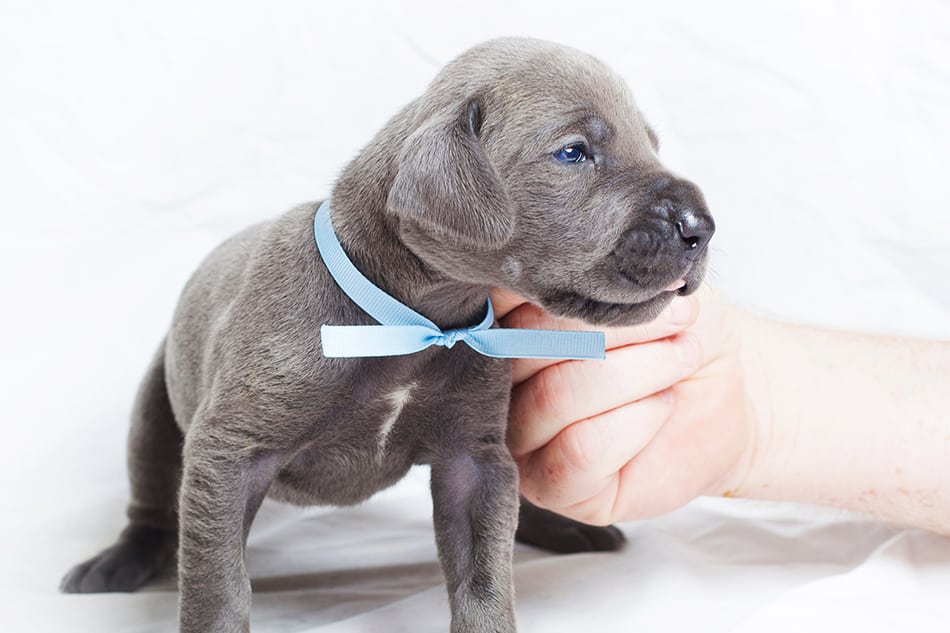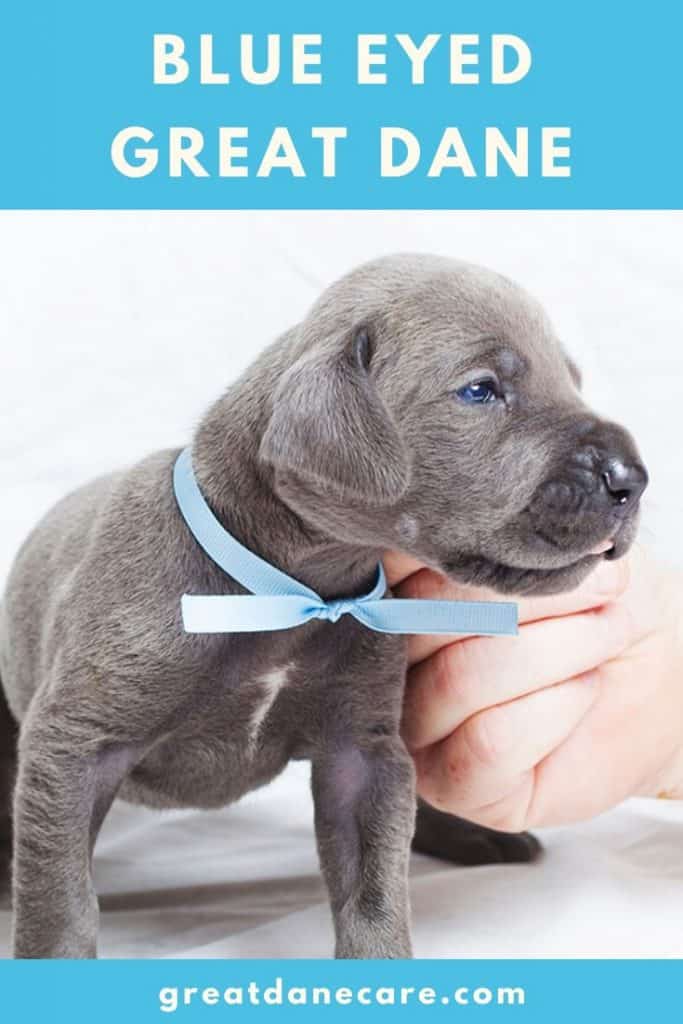
You probably just brought home a Great Dane puppy, and the first thing your wife commented on is how blue its eyes are. Looking through pictures on google, you see that a Great Dane’s eyes have the capacity to be different colors.
So, will your Great Dane’s Eyes stay blue? For the most part, no. Great Dane’s eyes are only blue as a puppy, and once they begin to mature, they morph into a shade of brown. The only exception is the harlequin Great Dane; their eyes can stay blue throughout their entire life.
But all puppies are born with blue eyes. The typical color for any dog eye is brown; the only reason why they would be any color other than brown is due to health and genetics. While uncommon, there are certain dog breeds that are more likely to share abnormal eye colors.
Why Are Their Eyes Blue?
Blue eyes are a result of the presence of the Merle gene. The Merle gene is when the cells are unable to form pigment. It can affect the nose, the fur, and, you guessed it, the eyes.
The more pigment dilution the dog has on their fur or skin, the more likely they are to be born with blue eyes rather than brown.
However, any dog with the Merle gene is not guaranteed to have blue eyes forever. The one exception here is for Harlequin Great Danes. Their blue eyes may last from puppy through adulthood.
By comparison, Blue Great Danes that are produced from Harlequins may have stunning blue eyes at birth that unfortunately change as they grow older. While that blue on blue combination is beautiful, just be aware that it’s not likely to last.
As stated before, all puppies are already born with blue eyes, which will start to change at around 10 weeks old, but you will not know for sure until they are grown.
It’s not uncommon to see changes in eye color until 4 months of age. Some breeds are more susceptible to the gene than others, including a Great Dane.
Some Great Dane’s are also known to have blueish-stormy gray eyes. Others can have pale blueish-white iris with some flecks of brown, which is known as “wall eyes.”
Health Problems with Blue Eyes (Merle Gene)
It is not the blue eyes themselves that cause the health problems, but rather the Merle gene that can cause a bit of complication with your Great Dane. Any two dogs that breed with the Merle gene trait have the potential to produces puppies expressing the “double merle” gene.
The Merle gene can increase the chances of puppies being born deaf, blind, both or with microphthalmia. Microphthalmia is when the eyes are unusually small, if there at all.
This is why breeding two dogs with the Merle gene trait is considered unethical —as it raises the potential for suffering from resulting litters.
But if you wish to breed one carrier with one that does not have the trait, then that is absolutely fine; for some reason, those puppies do not have any type of health problems regarding the gene.
Another thing to look out for is heterochromia. Heterochromia is when one eye color is not the same as the other.
This can be the result of the Merle gene and a Great Dane, or any dog really, that has heterochromia is put at a larger risk for cataracts or glaucoma. Either of those can cause untreatable blindness in a Great Dane in as little as two years of age.
The Merle gene is mainly an issue because of the lack of pigment on the more important parts of the dog, like the eyes and inside the ears. The Merle Gene can also cause sun sensitivity and skin cancer.
Other Health Concerns with Eyes
The Merle gene is not the only thing that can impact your dog’s eyes. If you have a Great Dane, there are some other health concerns that you should look out for, especially regarding their eyes.
Cherry eyes
Cherry eyes are something many people have seen in their Great Danes. It happens when the pink tissue from the corner of the eye shows when they are sleepy or on a drug. It is also known as a “third eyelid.”
The third eyelid possesses a tear gland that creates 1/3 of Dane’s tears. This is simply a genetic characteristic that can lead to the cartilage curling in an odd way.
Whenever this occurs, the third eyelid is pushed up and exposes the corner of the eye. Once the cartilage is curled, your Dane will not be able to push the tissue back where it was before.
While there is no definite long-term health issue to be on the lookout for, the exposed tissue might become irritated from the buildup of discharge.
Because of it being rubbed by the exposed tissue, the cornea can become inflamed, or their eyes may just end up being extremely dry, which can become a problem later on if not treated properly.
You can pick up a prescription for anti-inflammatory eye ointment from the vet for the tissue to stay moist so that it is not uncomfortable; however, the ointment is not a cure-all.
You could also get surgery for the cherry eye, but there is still the chance of it coming back. As long as you do your research right and find a very reliable vet surgeon to do the procedure properly, you will have no further issues.
For more information about cherry eye, make sure to take a look at our dedicated article on the topic here.
Entropion
Entropion is when the eyelid rolls inward. This causes the hair on the surface of the eyelid to rub against the cornea, which can be painful to your dog or even cause corneal ulcers and erosions.
The damage to the cornea could end in scarring that can really mess up your dog’s vision.
If your dog is seen to be squinting, tearing up, then they might be trying to tell you that something is wrong with their eyes. Unfortunately, most dog owners do not notice that their dog is suffering until most of the damage has already been done.
To fix corneal ulcers, the most definite way would be through surgery. A section of the skin is taken away from the impacted eye to reverse it going inward, but surgery is typically suggested only after the dog is fully mature. So, at around 6 to 12 months old.
Once the dog has healed from the first surgery, they must undergo a second smaller procedure. The second one is to make sure that the eyelid is not “overcorrected,” which is called ectropion. The outward rolling of the eyelid.
PRA
Aside from cherry eyes and entropion is something called PRA (Progressive Retinal Atrophy), which is a genetic disease that affects the retina. It is when the rod cells in the retina are organized to die.
The disease is not painful, but will eventually lead to total blindness within one year of being diagnosed.
The process happens very slowly, which would give your dog ample time to adjust as their vision is deteriorating. You may notice how reluctant your dog becomes to go outside at night or even go up and down the stairs as it starts more difficult for them to see in the dark.
The dog’s pupils will also dilate while trying to bring in more light, and after a while, even seeing during the day may rise as an issue too.
Another telltale sign is a film like shine coating the dog’s eyes called tapetal reflection that you would be able to notice along with the dilated pupils.
Since PRA happens so gradually, the dog may not show any other signs that they are losing their sight, they simply learn to adjust. Which is why you should make sure to keep a close watch on them, especially as they age.
Take them to the vet regularly, especially if you have a breed that is known to suffer from these types of health problems.
Having a Great Dane can be a blessing, but if you do not think you are ready to handle all that comes with this specific breed, then maybe you should hold off.
Like all dogs, Great Dane’s will love you until the very end, asking for nothing but to be loved and cared for in return.


This article needs an update. While Harlequins do commonly get a blue eye, it’s also common for blues to have blue eyes. Just got my blue puppy and I thought her Smokey blue eyes would stay blue but they actually turned amber. Several of her merle litter-mattes ended up with bright blue eyes. Great Danes at so much fun because they’re a mixed bag!
Thanks for pointing this out Lisa. I made some updates to clarify 🙂
I have a Blue Merle Great Dane and her eyes are Blue and most likely will remain blue form what the vet and breeder have said. She is 12 weeks tomorrow and the vet said the eyes will change by then if they are going to